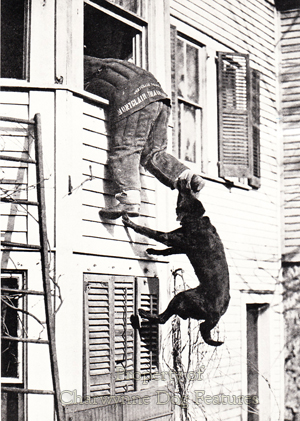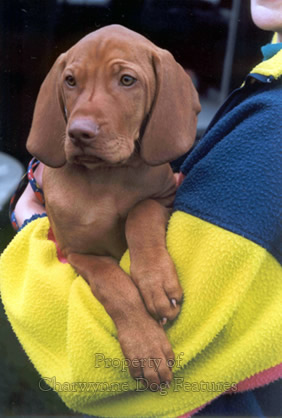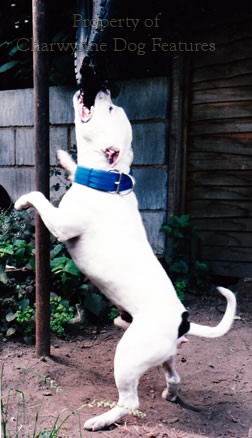345 Creating Dangerous Dogs
CREATING DANGEROUS DOGS
by David Hancock

 There's a subject far more important than rosette winning, judging appointments or committee posts and it's one so often avoided or evaded. It concerns temperament in our breeds of dog. Most dogs of any breed ending up 'in rescue' are there because they display problems in their temperament. This means that even good working dogs are unacceptable in the family environment because they cannot be trusted temperamentally. Owners of dodgy dogs all too often make lame excuses for them. But it is not unknown either for the dreaded 'kennel blindness' to affect those with working dogs of untrustworthy temperament, even to the extent of breeding from such flawed stock.
There's a subject far more important than rosette winning, judging appointments or committee posts and it's one so often avoided or evaded. It concerns temperament in our breeds of dog. Most dogs of any breed ending up 'in rescue' are there because they display problems in their temperament. This means that even good working dogs are unacceptable in the family environment because they cannot be trusted temperamentally. Owners of dodgy dogs all too often make lame excuses for them. But it is not unknown either for the dreaded 'kennel blindness' to affect those with working dogs of untrustworthy temperament, even to the extent of breeding from such flawed stock.
I don't have a problem with male dogs which are a bit sharp with other dogs or bitches which take a dislike to a litter-sister or dogs with a strong guarding instinct. The problem lies not with dogs with predictable attitudes but those which bite humans without warning and for no discernible reason. These are the dogs which are capable of shaming the breed, or, worse, getting the breed banned as a dangerous one. This is a topic which more than any other at the moment demands a debate. If not, some precious breeds will face an uncertain future.
Experts mention three possible causes of bad temperament: bad upbringing, heredity and the dog's own nature, unrelated to its breeding or upbringing. Working dogs can be members of a very dominant breed, terriers especially -- and with their heritage that's hardly surprising. But a dog of any size, allowed to be too dominant, is a definite danger. We all know of cases where the dog is allowed the run of the house, to replace its owner as pack-leader and display unwanted aggression without being checked. A well-known Bullmastiff breeder used to warn visitors "Don't look at the dog when I let him into the room"; another would warn "Don't stand up whilst the dog is with us" and another would advise "Whatever you do, don't touch him!"
Such warnings tell you more about people than about their dogs. You have to ask the crucial question: Who's in charge, the dog or the owner? Such dominance is quite intolerable and in a small pack of dogs horribly dangerous. Yet there are well-known breeders who allow their dogs to take charge, to assert themselves, to become the boss. One Neapolitan Mastiff 'expert', ever ready to pronounce on the breed, was once forced to take refuge in his own bedroom when his dominant dog asserted itself too forcibly. There is a huge difference between a perfectly natural guarding instinct and an unacceptable degree of dominance. When I was a soldier I had experience of guard-dogs, anti-ambush dogs, tracker dogs and detection dogs; those in the first two categories could be more than fierce--but they were always under control.
Upbringing clearly matters a great deal. My first two Bullmastiffs were both male and lived with us as pets. Their early squabbles as pups were very firmly dealt with and they subsequently grew up to be contented kennel mates. But breeding matters too. What do scientists tell us about the inheritance of temperament? The American Vet Leon Whitney crossed a Bull Terrier bitch, regarded as a natural killer and fighter, with a placid Bloodhound. He found that two of the resultant pups, all raised the same, possessed suspect temperament, one having to be destroyed because of its innate aggression. Another mating between a placid Bull Terrier bitch and a Bloodhound produced no offspring with flawed temperament. Of the fourteen pups from these two matings only two had faulty temperaments, both from the aggressive Bull Terrier bitch..jpg)
Humphrey and Warner, in their Working Dogs of 1934, showed that excessive timidity, which can lead to 'fear-biting', could be bred out, with more than one factor or gene governing this trait. Bold, confident dogs with controlled dominance have been found to be less likely to bite people than excessively timid dogs. The latter should never be bred from. The guarding instinct is itself strongly inherited; wilful pups sold to unsuitable homes can end up creating problems for their new owners. The experiments of Kruskinsky showed that excessive shyness, which can lead to 'fear-biting', increased markedly when two shy dogs were mated to each other. 
In his Genetics for Dog Breeders of 1990, Roy Robinson writes on breed differences: "That inherited differences do exist is indisputable, as shown by the various breed categories with different modes of behaviour. A small part of this variation could be imitative or learnt from the mother, siblings or older members of a kennel, but the major part is instinctive." This means that an aggressive dam can adversely influence her offspring both before and after their birth. It means too that an over-aggressive male dog can influence the younger members of the same kennel. Robinson went on to state "...there is the excessively excitable, nervous or highly-strung animal...such behaviour is likely to be inherited and individuals showing such behaviour should not be used for breeding."
In his Practical Genetics for Dog Breeders of 1992, Malcolm Willis writes: "Cowardly or excessively aggressive animals have no place in any breeding programme no matter how beautiful they may be." He sets out a table which shows that the heritability of nervousness is 50% and that of temperament 30-50%. Abnormal temperament can be a matter of chance too as Hodgman indicated in 1963; he did stress however that selection in certain breeds for assertive behaviour made this more likely. Thompson in 1957 showed that the individual dog is subjected to external influences which affect its behaviour from the moment of birth but it is likely that heredity is a major contributor to behavioural traits. Socialisation is clearly an important factor in later behaviour.
Eberhard Trumler, in his highly perceptive book Understanding Your Dog of 1973, wrote: "Again the behaviour of the dog which has been badly brought up during its socialisation phase will later bear an astonishing resemblance to that which, in human society, leads to the drop-out or the criminal." Pups which have simply been left to starve spiritually in an outhouse from three to seven weeks of age will find the real world a frightening and daunting place. That is why puppy-farms are such a danger to the production of future family pets. Abnormal aggression is a defence mechanism in a fearful dog. Territorial aggression is natural but still requires controlling. Young dogs have much to contend with: inadequate socialisation, aggression inherited from their forebears or aggression picked up from imitating older dogs. 